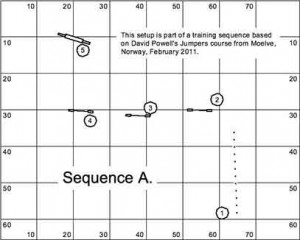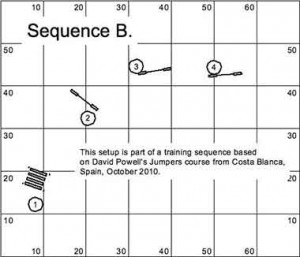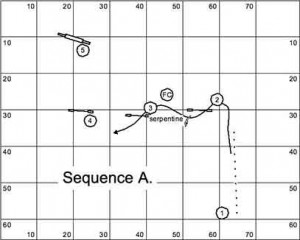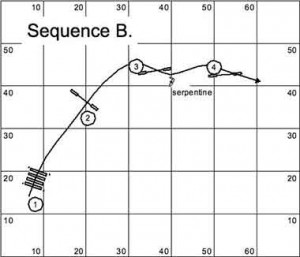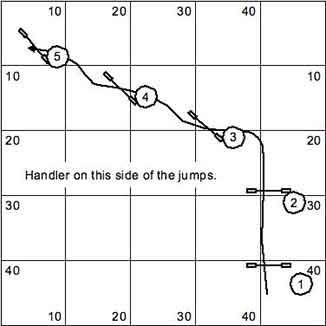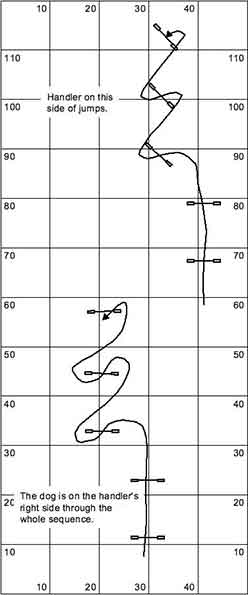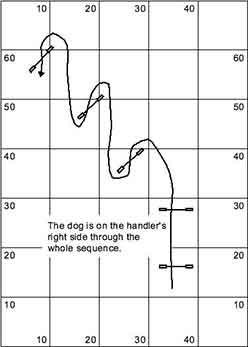Teeter Training
How to teach the teeter-totter
The teeter-totter performance is composed of three phases:
- ascending the teeter-totter
- riding the board to the ground
- and descending the board into a two-on, two-off position.
The way to achieve a fast and confident teeter performance is to teach each phase as separately from one another as possible. Only once the dog performs each rapidly and with confidence does the handler work to put all three together.
Start with the last phase first – Descending the board.
I. Descending the teeter board into the two-on, two-off position:
In the very last stage of the dog’s teeter performance, when the dog is about to exit the teeter-totter, the obstacle resembles the down ramp of the dogwalk. By using the method of back-chaining, train the dog to rapidly run down the down ramp into the two-on, two-off position. Since this method of teaching the dogwalk is well known, I’m not going to demonstrate it here.
II. Ascending the teeter-totter:
To perform the teeter-totter quickly, the dog has to be able to ascending the teeter board with great confidence. At no point in this part of the training is the board pivoting or otherwise moving.
Teach the dog to walk and run on a teeter board laying flat on the ground. Make sure the board does not move at all.
Place the teeter on its pivot, lower the teeter to its lowest adjustable setting, and prop up the end of the board that the dog performs last so that there is absolutely no movement in the board. Have a friend hold the dog while you go to the end of the board and call the dog to the end of the teeter board. Reward the dog with a treat while he is still on the board. Use the reward to encourage a rapid performance of the propped up board and to control the dog’s position on the board. You don’t want him to jump off just yet. Be sure to release the dog with an explicit command. You don’t want him to decide when the obstacle performance has been completed. You need to teach him that you are the one who makes this decision.
Once the dog is doing the lowered, propped-up teeter with speed and confidence, you can start raising the height of the pivot point. At each point in this stage of the training, there is absolutely no movement in the teeter board. If your teeter totter has a limited number of positions for the pivot point, you can achieve the same effect of gradually increasing the slope of the teeter by positioning tables of differing heights at each end of the teeter. Continue raising the slope of the teeter as much as it safe and practical.
III. Riding the moving board to the ground (Aspects of this part of the training are difficult to achieve with large dogs):
Return the teeter board to the lowest pivot point position. Place a prop under the last part of the board that the dog performs. This prop, however, will be too short to actually reach the underside of the board. It will be low enough to enable the board to move down an inch or two. Have an assistant hold your dog at the entrance to the obstacle. Go to the end of the board and hold it up. Ask your dog to perform the teeter while you are holding the board off the ground. In as much as you can, don’t let the board move as your dog runs to you. Give the dog a treat for running to the end of the board. Lower the board gently down one or two inches until it hits the prop beneath the board. Repeat this process all the while making sure that the dog is not starting to slow or become afraid because the board is moving. If the dog does start to slow, prop the board up again and train to regain his confidence. Your goal is twofold: to gradually remove more and more of the prop away so that the drop to the ground is lengthened and to gradually allow the fall to the ground to be more and more abrupt. I always give my dog at least two treats in this part of the training – one reward for running to the end of the board, and one reward for riding the board to the ground.
Gradually raise the pivot point. Gradually increase the distance that the board falls to the ground. (You can always moderate the speed by which the board reaches the ground by holding it for most of the way down.) If at any point, your dog gets worried or becomes less confident, back up a step and make the process easier for the dog.
You won’t need to train the dog to drop from the highest point possible at the end of the teeter. In any normal performance of the teeter, by the time the dog has reached the end of the board, the end of the teeter has already started to descend before it reaches the “free fall” state.
IV. Putting it all together:
Prop the entrance to the teeter up so that it resembles the down ramp of the dogwalk. Have the dog perform the propped up teeter as if it were the last part of the dogwalk (i.e., into the two-on/two-off position). Lower the prop by two or three inches. Now when the dog performs the teeter and reaches the very end of the board, the teeter will fall two or three inches to the ground. Since you have already taught the dog to withstand drops from much higher up, this challenge will be easy for the dog. Gradually lower the props in two or three inch increments. Increasingly, as the props disappear, the teeter will come to resemble, not the down ramp of the dogwalk, but the teeter totter as it appears in competition. If at any point, your dog gets worried or becomes less confident, back up a step and make the process easier for the dog. If necessary, go back to training phases II or III.

